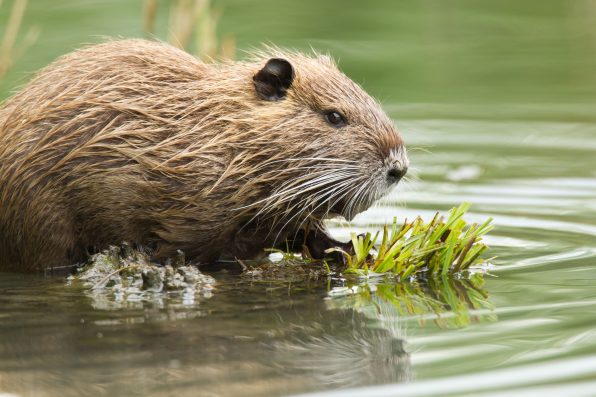These Large, Semi-Aquatic Rodents Known As Nutria Are Native To South America, But Are Now An Invasive Species Wreaking Havoc On Wetlands

When an animal, plant, or insect gets taken out of its original habitat and introduced to a new one, it’s less likely to have any natural predators.
Left unchecked, invasive species can wreak havoc on the environment, destroying native plants, decimating local animal populations, and bringing disease. There are several invasive species that still pose a threat in the United States today. One of them is the nutria.
Nutria are large, semi-aquatic rodents that are native to South America. They have dark brown fur, webbed feet, and a pair of long, orange front teeth. They resemble beavers closely, although they are smaller with arched backs, round, slender tails, and white whiskers.
Nutria first found their way to the United States around the beginning of the 20th century when the fur trade was booming. They were introduced to California in 1899 as a new source of fur-bearing animals for trappers. Their coarse, beaver-like fur was appealing for its warmth and waterproof qualities. By the 1930s, nutria were present in seven states.
After numerous escapes, nutria established themselves in marshy wetland areas near permanent freshwater sources, particularly in Louisiana and Maryland. Since then, they have been spotted in 30 states and are currently established in as many as 18 states.
The nutria’s prolific eating habits and high reproduction rates have a detrimental effect on the habitats they have infiltrated. The rodents have a broad diet that consists of large amounts of roots, cattail tubers, and other vegetation found near wetlands.
Their eating, digging, and swimming cause massive erosion, contributing to the collapse of marshes and turning them into open habitats, which is harmful to native species.
The impact of nutria on valuable wetlands, such as the Chesapeake Bay in Maryland, has not gone unnoticed. The area is important for hunting, fishing, and ecotourism. Nutria damage will not only lead to significant ecological loss but cultural and economic losses as well.
The destruction that nutria brings is not limited to the plants found in marshes. They also feed on crops. In the United States, the primary crops they graze on are rice and sugarcane. Other crops include corn, wheat, barley, oats, peanuts, and melons.

DenZ0r – stock.adobe.com – illustrative purposes only, not the actual nutria
Furthermore, nutria can carry various pathogens and parasites, affecting public health and safety. The rodents serve as hosts for tuberculosis and septicemia, which are threats to people, pets, and livestock.
In addition, nutria carry tapeworms, blood and liver flukes, and a nematode that can cause a rash known as “nutria itch.” These organisms are found in nutria waste, which can contaminate drinking water and swimming areas.
Wildlife officials have instituted control programs to try to stop the nutria from causing further damage. The most successful effort to date has been in Maryland. In 2002, the mission to remove nutria from an area of 800 square miles began.
In 2006, the eradication zone was expanded. Over the course of 12 years, tens of thousands of nutria were eliminated from nearly half a million acres. Their reduced population size had an immediate positive effect in the regions they invaded, demonstrating that less nutria meant less marsh damage.
Today, the area is still being monitored to confirm the absence of the nutria, and similar efforts are underway in states like California.
Sign up for Chip Chick’s newsletter and get stories like this delivered to your inbox.
More About:Animals





